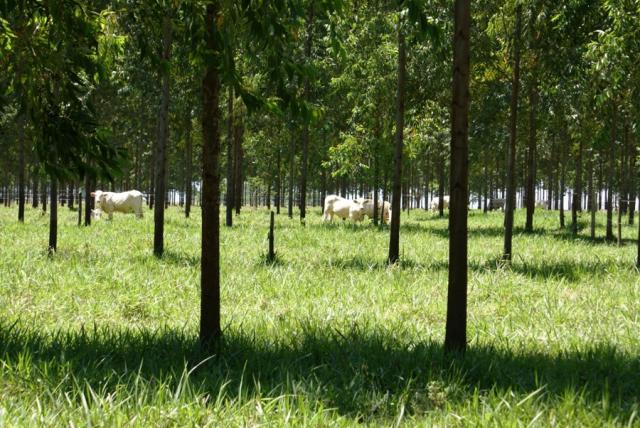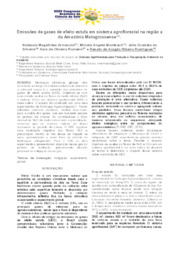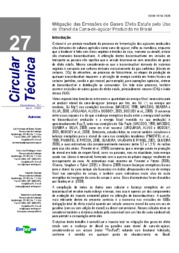The researcher Robert Boddey is going to deliver a series of lectures in the United States this week about Embrapa's research to reduce greenhouse gas emissions in Brazilian agriculture. One of the presentations will be offered to Climate Smart Agriculture experts at the World Bank headquarters, in Washington, D.C. "I am going to present what Embrapa has been doing and explain that emissions have decreased a lot since 2004, which is the result of research and of the Brazilian government's effort to curb deforestation in the Amazon region and in other areas", anticipated Boddey. In addition to the meeting with experts on Climate Smart Agriculture – an approach advocated by FAO which aims at mobilizing resources to increase productivity with sustainability and reduced greenhouse gas emissions in food production –, the researcher Robert Boddey is going to meet researchers from the Princeton University's Program in Science, Technology and Environmental Policy (STEP). At the institution, Boddey is going to give a lecture for about 100 researchers, professors and students. The researcher does not rule out the possibility of future partnerships with American universities and research centers. For Robert Boddey, who works at Embrapa Agrobiology (Seropédica, RJ), the invitation for such presentations at the United States is the recognition of the nutrient cycling team's work in 20 years of studies. The researcher asserts that their wish to learn more about Embrapa's studies on the topic reveals a great interest in Brazilian research. "They want to know how Brazil intends to fulfil the ambitious commitments pledged in Copenhagen (2009) and at the 21st Conference of the Parties-COP21, in Paris (2015), to reduce GHG emissions, especially from agriculture", he adds. Research at Embrapa Among the research cases that are going to be presented, Robert Boddey will address a recent study that reveals that greenhouse gas emissions in Brazilian cattle farming can fall as pasture productivity is increased. The study assessed five different scenarios, which range from degraded pasture conditions to fertilized pastures combined with confinement. "That study allowed us to estimate the amount of GHG emissions per kilo of beef produced in the country according to the type of management adopted", clarifies the researcher, who coordinated the research. The estimates were based on IPCC's methodology, with data surveyed from Brazilian research. Boddey explains that with a slight improvement like intercropping pastures with a forage legume, which does not require nitrogen fertilization, combined with better animal control, it is possible to obtain an emission reduction of approximately 26% in comparison with degraded pastures, and a fourfold increase in productivity. With increased productivity, the emission reduction per kilo of can reach nearly 50%. Learn more about Embrapa's research about the topic: https://www.embrapa.br/tema-agricultura-de-baixo-carbono/sobre-o-tema https://www.embrapa.br/web/portal/busca-de-noticias/-/noticia/3272611/pecuaria-brasileira-emite-menos-gases-de-efeito-estufa-do-que-o-estimado-pelo-ipcc https://www.embrapa.br/web/portal/busca-de-noticias/-/noticia/8313328/fixacao-biologica-de-nitrogenio-pode-reduzir-as-emissoes-de-gee-na-agricultura https://www.embrapa.br/busca-de-noticias/-/noticia/14184247/plantio-direto-contribui-para-mitigacao-dos-gases-de-efeito-estufa https://www.embrapa.br/busca-de-noticias/-/noticia/13239171/pesquisa-desenvolve-conceito-carne-carbono-neutro-para-producao-bovina https://www.embrapa.br/cop22 Learn more about Brazil's commitments: http://www.mma.gov.br/clima/convencao-das-nacoes-unidas Translation: Mariana de Lima Medeiros
The researcher Robert Boddey is going to deliver a series of lectures in the United States this week about Embrapa's research to reduce greenhouse gas emissions in Brazilian agriculture. One of the presentations will be offered to Climate Smart Agriculture experts at the World Bank headquarters, in Washington, D.C. "I am going to present what Embrapa has been doing and explain that emissions have decreased a lot since 2004, which is the result of research and of the Brazilian government's effort to curb deforestation in the Amazon region and in other areas", anticipated Boddey.
In addition to the meeting with experts on Climate Smart Agriculture – an approach advocated by FAO which aims at mobilizing resources to increase productivity with sustainability and reduced greenhouse gas emissions in food production –, the researcher Robert Boddey is going to meet researchers from the Princeton University's Program in Science, Technology and Environmental Policy (STEP). At the institution, Boddey is going to give a lecture for about 100 researchers, professors and students. The researcher does not rule out the possibility of future partnerships with American universities and research centers.
For Robert Boddey, who works at Embrapa Agrobiology (Seropédica, RJ), the invitation for such presentations at the United States is the recognition of the nutrient cycling team's work in 20 years of studies. The researcher asserts that their wish to learn more about Embrapa's studies on the topic reveals a great interest in Brazilian research. "They want to know how Brazil intends to fulfil the ambitious commitments pledged in Copenhagen (2009) and at the 21st Conference of the Parties-COP21, in Paris (2015), to reduce GHG emissions, especially from agriculture", he adds.
Research at Embrapa
Among the research cases that are going to be presented, Robert Boddey will address a recent study that reveals that greenhouse gas emissions in Brazilian cattle farming can fall as pasture productivity is increased. The study assessed five different scenarios, which range from degraded pasture conditions to fertilized pastures combined with confinement. "That study allowed us to estimate the amount of GHG emissions per kilo of beef produced in the country according to the type of management adopted", clarifies the researcher, who coordinated the research.
The estimates were based on IPCC's methodology, with data surveyed from Brazilian research. Boddey explains that with a slight improvement like intercropping pastures with a forage legume, which does not require nitrogen fertilization, combined with better animal control, it is possible to obtain an emission reduction of approximately 26% in comparison with degraded pastures, and a fourfold increase in productivity. With increased productivity, the emission reduction per kilo of can reach nearly 50%.
Learn more about Embrapa's research about the topic:
https://www.embrapa.br/tema-agricultura-de-baixo-carbono/sobre-o-tema
https://www.embrapa.br/web/portal/busca-de-noticias/-/noticia/3272611/pecuaria-brasileira-emite-menos-gases-de-efeito-estufa-do-que-o-estimado-pelo-ipcc
https://www.embrapa.br/web/portal/busca-de-noticias/-/noticia/8313328/fixacao-biologica-de-nitrogenio-pode-reduzir-as-emissoes-de-gee-na-agricultura
https://www.embrapa.br/busca-de-noticias/-/noticia/14184247/plantio-direto-contribui-para-mitigacao-dos-gases-de-efeito-estufa
https://www.embrapa.br/busca-de-noticias/-/noticia/13239171/pesquisa-desenvolve-conceito-carne-carbono-neutro-para-producao-bovina
https://www.embrapa.br/cop22
Learn more about Brazil's commitments:
http://www.mma.gov.br/clima/convencao-das-nacoes-unidas
Translation: Mariana de Lima Medeiros




